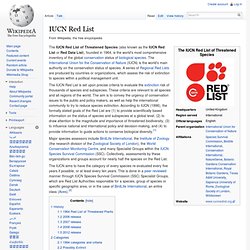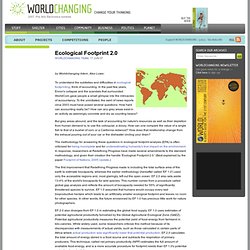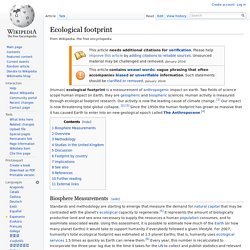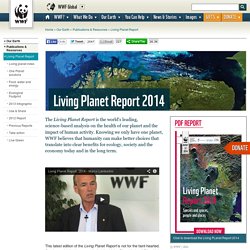

Cartogram.gif (Image GIF, 1000x580 pixels) Human welfare and ecological footprint.jpg - Wikipedia, the free encyclopedia. Principle 2: Ecological Footprints and One Planet Thinking. The green space is teeming these days with lengthy and complex explanations about the meaning of sustainability.

But from that wealth of information, two exceptionally simple methods emerge for understanding what such a planet would actually look like, and how we can get there. Ecological Footprint and One Planet both frame human impact in terms of physical space. One indicates the space we exploit through our consumption patterns, and the other indicates the space we have to share -- equitably and permanently -- as a global population, if we intend to sustain life on Earth.
The concepts distill daunting challenges into individual goals: If we can each shape our own footprints such that they never exceed what the planet can support, we'll accelerate our progress exponentially. Winning the Great Wager -- A shrinking planet, a growing population: How do we redesign the world and achieve sustainable prosperity for every person living here? Creative Common's Photo Credit. Natural Resources Defense Council - The Earth's Best Defense. IUCN Red List. The IUCN Red List of Threatened Species (also known as the IUCN Red List or Red Data List), founded in 1964, is the world's most comprehensive inventory of the global conservation status of biological species.

Ecological Footprint 2.0. By Worldchanging Intern, Alex Lowe: To understand the subtleties and difficulties in ecological footprinting, think of accounting.

In the past few years, Enron's collapse and the scandals that surrounded WorldCom gave people a small glimpse into the intricacies of accountancy. To the uninitiated, the swirl of news reports circa 2003 must have posed several questions: How hard can accounting really be? How can any grey areas exist in an activity as seemingly concrete and dry as counting beans? But grey areas abound, and the task of accounting for nature's resources as well as their depletion from human demand is, to use the colloquial, a doozy.
The methodology for answering these questions in ecological footprint analysis (EFA) is often criticized for being incomplete and for underestimating humanity's true impact on the environment. EF 2.0 also diverges from EF 1.0 in estimating the global food supply. Other researchers have added to the standard EF 1.0 methodology in different ways. Ecological Footprint - Home. Please note that this website will be shut down at the end of 2013. You can find other ecological footprint calculators at the Global Footprint Network and the WWF-Australia websites. People often get disillusioned by sustainability, saying it is too complicated to understand, when in actual fact it is really quite simple.
Ecological Footprint. Ecological Footprint What Is the Ecological Footprint?

The Ecological Footprint is rooted in the fact that all renewable resources come from the earth. It accounts for the flows of energy and matter to and from any defined economy and converts these into the corresponding land/water area required for nature to support these flows. The Ecological Footprint is defined as "the area of productive land and water ecosystems required to produce the resources that the population consumes and assimilate the wastes that the population produces, wherever on Earth the land and water is located. "1 It compares actual throughput of renewable resources relative to what is annually renewed. Ecological Footprint Quiz by Center for Sustainable Economy.
Neutral Existence LLC. Greenhouse Gas Data Publication Tool. HOME - Ecological Footprint - Ecological Sustainability. Global-carbon-footprint_50290b0baf4ce.jpg (Image JPEG, 1118x2000 pixels) Ecological footprint. (Human) ecological footprint is a measurement of anthropogenic impact on earth.

Two fields of science scope human impact on Earth; they are geospheric and biospheric sciences. Human activity is measured through ecological footprint research. Our activity is now the leading cause of climate change. [1] Our impact is now threatening total global collapse. [2] [3] Since the 1950s the human footprint has grown so massive that it has caused Earth to enter into an new geological epoch called The Anthropocene.[4] Biosphere Measurements[edit] Standards and methodology are starting to emerge that measure the demand for natural capital that may be contrasted with the planet's ecological capacity to regenerate.[5] It represents the amount of biologically productive land and sea area necessary to supply the resources a human population consumes, and to assimilate associated waste.
Living Planet Report. The Living Planet Report is the world's leading, science-based analysis on the health of our planet and the impact of human activity.

Knowing we only have one planet, WWF believes that humanity can make better choices that translate into clear benefits for ecology, society and the economy today and in the long term. This latest edition of the Living Planet Report is not for the faint-hearted. One key point that jumps out is that the Living Planet Index (LPI), which measures more than 10,000 representative populations of mammals, birds, reptiles, amphibians and fish, has declined by 52 per cent since 1970.
Put another way, in less than two human generations, population sizes of vertebrate species have dropped by half. WWF Footprint Calculator.